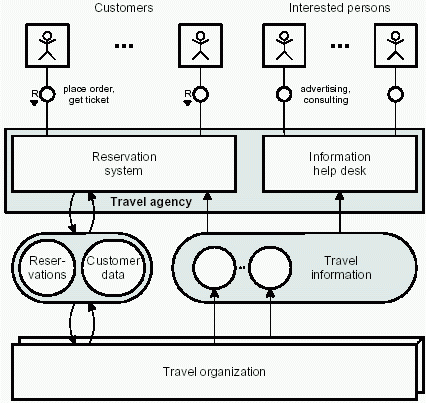
|
Figure C.1 shows a block diagram which represents a model of the static compositional structure of a travel agency system and its environment. In the upper part of the block diagram several rectangles are shown, each containing the stylized figure of a human. The left group are customers of the travel agency interacting with the reservation system. Reservation orders can be placed, which are transmitted to the corresponding travel organizations, while the customers are issued their tickets. To the right are those persons looking for travel information using the information help desk. This information is provided by the different travel organizations and is stored in a location symbolized by the big rounded rectangle labeled travel information.
The block diagram in figure C.1, like any block diagram, represents a real or at least imaginable real informational system. The system being described is not more abstract than anything else we consider to be real. Looking at the system we see components, artifacts of our mind, which relate to tangible distinguishable physical phenomena, like an apple, a computer, our family or a TV station -- entities which exist in time and space. So an informational system can be seen as a composition of interacting components called agents. Each agent serves a well-defined purpose and communicates via channels and shared storages with other agents. If an agent needs to keep information over time, it has access to at least one storage to store and retrieve information. If the purpose is not to store, but to transmit information, the agents are connected via channels.
Agents are drawn as rectangular nodes, whereas locations are symbolized as rounded nodes. In particular, channels are depicted as small circles and storages are illustrated as larger circles or rounded nodes. Directed arcs symbolize whether an agent can read or write information from or to a storage.
In the example, the arcs directed from the nodes labeled "travel organization" to the storage node labeled "travel information" symbolize that the travel organizations write the travel information. Correspondingly the arc directed from the storage node labeled "travel information" to the agent node labeled "information help desk" symbolizes that the help desk reads the travel information. If an agent can modify the contents of a storage regarding its previous contents, it is connected via a pair of opposed bound arcs, called modifying arcs. The access of the reservation system and the travel organization to the customer data storage is an example.
If communication is possible in both directions, the arcs connecting the agents via the channel may be undirected. Looking the example, the communication between the help desk and the persons interested in some information is visualized that way. A very special, but common variant of this case is the request/response channels, where a client requests a service from another agent and after a while gets its response. To express, which side is requesting the service, a small arrow labeled with "R" for request and pointing from client to server, is placed beside the node symbolizing the channel. Examples are the channels between the customers and the reservation system.
 |
Apache Modeling Portal 2004-10-29 |